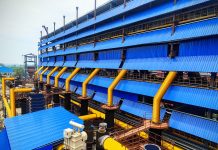Polymetallic nodules found on the ocean floor are emerging as alternative sources of Cobalt and Nickel, whose demand is surging on the back of the burgeoning growth of Lithium-ion batteries. Even as the environmental impact of deep sea mining is cloudy, pioneers are forging ahead with underwater trials.
Many attempts have been made to predict when the world will run out of fossil fuels; almost all of them have been proved to be incorrect. The current estimate is that we have a little more than 100 years of coal reserves and 50 years each of both oil and gas. But this conundrum has ceased to excite us, as it has been overshadowed by the looming climate change emergency. Alternatives to fossil fuels have already made significant technological advances and many climate scientists are calling for leaving the fossil fuels under the earth and immediately switch over to the cleaner alternatives. Like fossil fuels, many metals and minerals are also depleting from earth’s crust and this is now beginning to ring alarm bells. Some of these metals and minerals are important constituents of battery, an important driver of renewable energy.
Endangered Elements
According to American Chemical Society, 44 out of the 118 elements in the Periodic Table will vanish by the end of this century. The eight most endangered elements are Helium, Zinc, Gallium, Germanium, Arsenic, Silver, Indium, Tellurium and Hafnium. The applications of some of these most endangered elements are not so well known. Indium tin oxide, for instance, is an important constituent of the touchscreens in smartphones. Helium is required for cooling the superconductive magnetic coils in MRI scanners. Gallium is used to make high quality mirrors and is also extensively used in the semiconductor industry. Tellurium is often used to improve the machinability of copper and stainless steel. Germanium is an important ingredient of photodetectors used in television remotes and automatic opening doors in malls and offices. Many other metals including, Lithium, Magnesium, Chromium, Vanadium, Manganese, Cobalt, Nickel, Copper, Molybdenum, Palladium, Cadmium, Tin, Antimony, Tungsten, Gold, and Lead face the threat of supply disruptions in future.
Polymetallic Nodules
Covering vast areas of seabed are aggregates of iron and manganese hydroxide, known as Polymetallic Nodules or Manganese Nodules. These are found at depths of 4000 to 6500 meters and range in size from few millimeters to tens of centimeters. In addition to Manganese and Iron, these nodules contain Nickel, Copper and Cobalt in commercially attractive concentrations. Other valuable metals like Molybdenum, Zirconium and Rare Earths are also present in the nodules. The biggest deposits of Polymetallic Nodules have been located in the Eastern Pacific Ocean, in an abyssal plain of the ocean floor, known as Clarion-Clipperton Zone (CCZ), which lies between Hawaii and Mexico and spans an area larger than India at 4.5 million square kilometers. The International Seabed Authority (ISA), the UN body based in Kingston, Jamaica, set up to regulate the exploration and exploitation of marine non-living resources in international waters, has awarded 16 exploration contracts to assess mining opportunities in the CCZ. The other commercially attractive deposits of Polymetallic Nodules are found in the Central Indian Ocean Basin (CIOB), where the ISA has granted exploration rights of 75,000 square kilometers to India. Chennai-based National Institute of Oceanography (NIOT) has undertaken an ambitious project of placing a manned submersible vehicle to crawl the ocean floor at a depth of 6000 meters by 2021.
Cobalt and Nickel
Cobalt and Nickel are driving the new interest in Polymetallic Nodules. The potential of Polymetallic Nodules was known as far back as 1960s. However, it did not take off due to the availability of cheap Nickel and Cobalt from land based deposits. But with land based deposits depleting rapidly, due to a surge in demand for Nickel and Cobalt, two key constituents of Lithium-ion batteries, there is a renewed interest in Polymetallic Nodules. It is currently estimated that CCZ holds 6 times more Cobalt and 3 times more Nickel than all land based reserves.
First Movers
Global Sea Mineral Resources, a Belgian company, was the first to launch a vehicle to crawl on the ocean bed, after signing a 15-year contract with ISA to prospect for Polymetallic Nodules in CCZ. Named Patania, after the world’s fastest caterpillar, the crawler is being tested at depths of 4500 meters to harvest the nodules. Joining the underwater mining race is DeepGreen, a Canadian start-up. Since the nodules contain metals in combinations that do not occur in conventional land ores, current metallurgical processes for extracting and refining need to be modified. DeepGreen claim to have developed a process to fully utilise the nodules with the only waste stream being an iron-rich slag. The argument advanced by promoters of deep sea mining is that more than 60% of the global supply of Cobalt is presently emanating from Democratic Republic Congo, where child labour is rife.
Environmental Impact
Deep sea mining involves deployment of a vehicle that will crawl on the ocean floor vacuuming up the top layer. As the vehicle moves along the seabed, it will create a cloud of sediment or plume that will be carried away by the ocean currents. The material vacuumed by the crawler are pumped up to the mother ship, where the useful nodules will be separated from the unwanted sediments, which will be piped back to the ocean depths creating a second plume. The ocean sediments surrounding the Polymetallic Nodules harbour an extraordinary biodiversity and environmental scientists are rightly worried about the potential impact of disturbing the ocean floor for mining. Sediment accumulates on the ocean floor at the rate of 1 millimeter every 1000 years. Right now, there is little knowledge of the short and long term environmental consequences of deep sea mining. An international team of scientists funded by MIT have carried out fluid dynamic studies to see how deep sea mining would affect the marine environment and their preliminary finding is that local biology will be irretrievably impacted. Further studies are planned later this year by sending down a prototype crawler and developing models that will accurately predict the plume dispersion.
Epilogue
China holds most licenses for deep sea mining. According to one estimate deep sea mining will account for 15% of global supply of critical metals by 2050. Even as environmentalists are up in arms, ISA has drawn up rules and regulations for deep sea mining and they are expected to come into force by end of 2020.
Readers’ responses may be sent to: k.sahasranaman@gmail.com or
chemindigest@gmail.com
































